Industrial Robotics Market
Industrial Robotics Market Size and Share Forecast Outlook 2025 to 2035
Industrial robotics market is projected to grow from USD 37.8 billion in 2025 to USD 96.8 billion by 2035, at a CAGR of 9.9%. Handling will dominate with a 42.0% market share, while electricals/electronics will lead the end-use segment with a 31.0% share.
Industrial Robotics Market Forecast and Outlook 2025 to 2035
The global industrial robotics market is set to grow from USD 37.82 billion in 2025 to USD 96.81 billion by 2035, adding USD 59.0 billion in new revenue and advancing at a CAGR of 9.9%. Growth is driven by escalating demand for manufacturing automation validation, expanding smart factory infrastructure across regulated industrial markets, and accelerating productivity enhancement requirements among manufacturing and assembly organizations seeking precision production solutions.
Quick Stats for Industrial Robotics Market
- Industrial Robotics Market Value (2025): USD 37.82 billion
- Industrial Robotics Market Forecast Value (2035): USD 96.81 billion
- Industrial Robotics Market Forecast CAGR: 9.9%
- Leading Application in Industrial Robotics Market: Handling (42.0%)
- Key Growth Regions in Industrial Robotics Market: Asia Pacific, Europe, and North America
- Top Players in Industrial Robotics Market: ABB Ltd., Yaskawa Electric Corporation, Mitsubishi Electric Corporation, Nachi-Fujikoshi Corp., Comau SpA
- Where revenue comes from - now vs next (industry-level view)
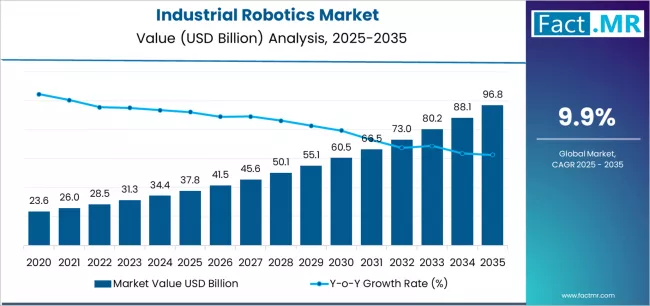
Industrial robotics technologies are increasingly recognized as essential tools for manufacturing practitioners, offering precise motion control capabilities, operational efficiency assurance, and comprehensive automation characteristics compared to traditional manual production approaches.
Handling applications dominate the market, favored in manufacturing and logistics environments for their established versatility properties, providing material movement mechanisms, pick-and-place capabilities, and universal deployment across diverse production operations and industrial demographics.
Electricals/electronics applications remain fundamental in assembly automation protocols where component placement precision and high-speed manufacturing match operational requirements and production quality confidence standards. Asia Pacific regions are advancing among geographic categories as specialized manufacturing facility networks expand and automation infrastructure increases accessibility in production-convenient locations with comprehensive industrial structures.
Geographic concentration demonstrates dynamic growth patterns with India and China leading expansion, supported by rising manufacturing capacity, industrial automation consciousness expansion among production populations, and robotics deployment establishment programs in manufacturing centers.
USA, Germany, Japan, South Korea, and Brazil demonstrate robust development through established manufacturing ecosystems, regulatory framework maturity for industrial equipment, and standardized acceptance of automation procedures. Competitive advantage is consolidating around payload capacity profiles, programming flexibility documentation, integration capability compatibility, and comprehensive automation solution portfolios rather than standalone robot formulations alone.
The first half of the decade will witness the market climbing from USD 37.82 billion to approximately USD 61.05 billion, adding USD 23.23 billion in value, which constitutes 39% of the total forecast growth period. This phase will be characterized by the continued dominance of handling applications in manufacturing settings, combined with accelerating adoption of collaborative robotics technologies in assembly applications where human-robot interaction and flexible deployment create favorable production outcomes.
The latter half will witness sustained expansion from USD 61.05 billion to USD 96.81 billion, representing an addition of USD 35.76 billion or 61% of the decade's growth, defined by broadening acceptance of artificial intelligence-enabled robotics and integration of autonomous mobile manipulation platforms across mainstream manufacturing facilities.
| Period | Primary Revenue Buckets | Share | Notes |
|---|---|---|---|
| Today | Handling | 42.0% | Application dominance |
| Electricals/electronics | 31.0% | Leading end use | |
| Automotive | 28.0% | Manufacturing foundation | |
| Welding & Soldering | 18.0% | Process automation | |
| Metal/Heavy Machinery | 16.0% | Industrial base | |
| Future (3-5 yrs) | Collaborative Robots | 38-44% | Human-robot interaction |
| AI-Powered Systems | 35-41% | Intelligent automation | |
| Mobile Manipulation | 28-34% | Autonomous mobility | |
| Electronics Assembly | 42-48% | Miniaturization demands | |
| EV Manufacturing | 32-38% | Automotive transformation | |
| Warehouse Automation | 35-41% | Logistics evolution | |
| Vision-Guided Systems | 30-36% | Adaptive robotics |
Industrial Robotics Market Key Takeaways
At-a-Glance Metrics
| Metric | Value |
|---|---|
| Market Value (2025) → | USD 37.82 billion |
| Market Forecast (2035) ↑ | USD 96.81 billion |
| Growth Rate ★ | 9.9% CAGR |
| Leading Application → | Handling |
| Primary End Use → | Electricals/electronics |
The market demonstrates exceptional fundamentals with Handling capturing a commanding 42.0% share through superior versatility characteristics, established application advantages, and proven flexibility profiles across manufacturing automation applications. Electricals/electronics drive primary end-use demand at 31.0% share, supported by established component assembly infrastructure and precision manufacturing requirements that maintain operational excellence across diverse electronics segments.
Geographic concentration remains anchored in Asia Pacific with dominant market leadership through manufacturing capacity expansion and automation infrastructure development, while developed markets show accelerated adoption rates driven by labor shortage demographics and productivity enhancement procedure preferences.
Imperatives for Stakeholders in Industrial Robotics Market
Design for flexibility and integration, not just automation
- Offer complete manufacturing solutions: advanced robotic systems + vision integration + programming platforms + safety systems + predictive maintenance capabilities.
- Preconfigured automation packages: assembly line specifications, material handling configurations, welding cell programs, and combination process protocols for diverse manufacturing requirements.
Integration readiness for manufacturing applications
- Comprehensive system documentation, automation engineering services, and deployment infrastructure (simulation tools, safety validation, production optimization protocols).
Affordability-by-design approach
- Cost-optimized robot portfolios, flexible deployment pricing models, manufacturer partnership programs, and transparent total cost of ownership documentation.
Application engineering-focused market penetration
- Established automation workshops + comprehensive certification programs (robot programming, safety integration, maintenance management); direct manufacturer engagement for relationship development and automation confidence building.
Segmental Analysis
The market segments by application into handling, welding & soldering, assembling & disassembling, processing, dispensing, cleanroom, and others, representing the evolution from basic material movement toward sophisticated manufacturing validation with process integration capabilities, precision execution characteristics, and specialized production requirements.
The end-use segmentation shows electricals/electronics' commanding 31.0% position, followed by automotive, metal/heavy machinery, chemical, rubber & plastics, food, and others, demonstrating varied manufacturing specialization levels and automation infrastructure concentrations.
Why are Handling Applications the Most Extensive Category for Industrial Robotics?
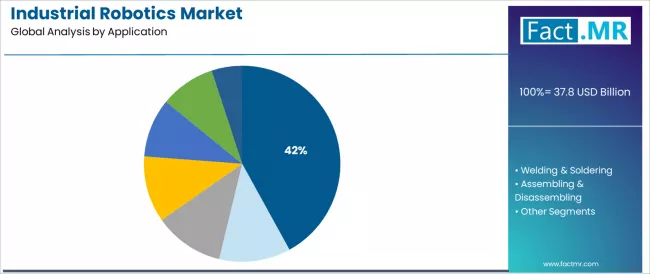
Handling commands the leading position in the industrial robotics market with a 42.0% market share through superior versatility characteristics, including universal application compatibility, straightforward deployment procedures, and broad industry acceptance that enable manufacturers to achieve predictable automation outcomes across varied production processes and diverse manufacturing demographics.
The segment benefits from flexibility advantages through multi-purpose capabilities, rapid reconfiguration potential, and proven operational reliability without requiring complex process engineering. Advanced robotic technology enables payload optimization, reach customization, and speed tuning, where material movement precision and cycle time efficiency represent critical manufacturing productivity requirements.
Articulated arm handling robots hold significant share within the application segment, appealing to manufacturers seeking comprehensive workspace coverage for diverse material handling scenarios. Handling robot products differentiate through proven versatility profiles, application breadth advantages, and integration with established manufacturing workflows that enhance production efficiency while maintaining reliable operational outcomes for diverse industrial applications.
Key market characteristics:
- Advanced kinematic properties with multi-axis flexibility and reproducible performance for material handling
- Superior deployment adaptability, enabling application diversity and production flexibility for manufacturing operations
- Comprehensive industry acceptance, including decades of proven installations and standard practice inclusion for automation applications
By End-Use, Which Category Dominates in the Industrial Robotics Market?
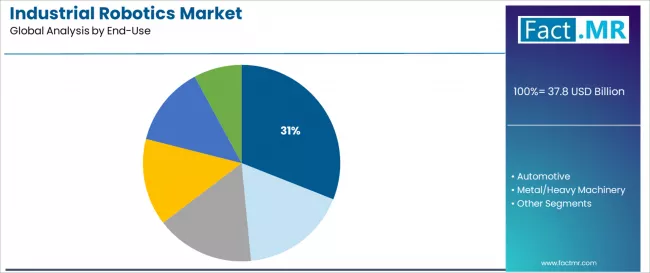
Electricals/electronics establish market leadership in the industrial robotics sector with a 31.0% share due to comprehensive automation requirements and sustained focus on component assembly, circuit board handling, and precision manufacturing that maximizes production efficiency while maintaining appropriate quality control standards.
Manufacturing engineers and production managers prioritize electronics manufacturing environments for mandatory precision requirements, comprehensive throughput capabilities, and integration with established assembly processes that enables coordinated production experiences across multiple product categories. The sector benefits from substantial miniaturization trends and quality assurance campaigns that emphasize robotic automation delivery for critical electronics assembly applications.
Consumer electronics expansion incorporates robotic assembly as standard production protocols for high-volume manufacturing, while semiconductor packaging development increases automation utilization that meets precision requirements and ensures consistent quality capabilities.
End-use dynamics include:
- Strong growth in smartphone manufacturing requiring validated assembly methods and consistent quality documentation arrangements
- Increasing adoption in semiconductor facilities for cleanroom automation and contamination control positioning
- Rising integration with surface mount technology for comprehensive electronics assembly and production optimization
What are the Drivers, Restraints, and Key Trends of the Industrial Robotics Market?
| Category | Factor | Impact | Why It Matters |
|---|---|---|---|
| Driver | Rising labor costs & workforce shortages (demographic shifts, wage inflation) | ★★★★★ | Labor challenges enable robotic automation demand for production efficiency validation; increasing workforce constraints drive robot adoption across manufacturing markets and diverse industrial segments. |
| Driver | Growth in manufacturing reshoring and local production initiatives (supply chain resilience, regional manufacturing) | ★★★★★ | Drives demand for automated production systems and flexible manufacturing solutions; facilities providing competitive local manufacturing gain advantage in resilience-focused industrial segments. |
| Driver | Industry 4.0 adoption and smart factory development (digital transformation, connectivity) | ★★★★☆ | Manufacturers demand intelligent automation systems and integrated production platforms; digital transformation expanding addressable segments beyond traditional manufacturing demographics and manual production clientele. |
| Restraint | High initial investment & implementation costs (capital requirements, integration expenses) | ★★★★☆ | Cost-conscious manufacturers face budget limitations and ROI concerns, restricting automation adoption and affecting technology penetration in resource-limited organizations and small-medium enterprises. |
| Restraint | Technical complexity & skills gap challenges (programming requirements, maintenance expertise) | ★★★☆☆ | Manufacturers face capability concerns and workforce limitations; increases implementation barriers and affects adoption penetration in smaller facilities and traditional manufacturing operations. |
| Trend | Collaborative robotics adoption & human-robot collaboration (cobots, safety systems) | ★★★★★ | Growing acceptance for shared workspace operation and flexible deployment approaches beyond traditional safety-caged installations; collaborative technologies become core differentiation strategy for adaptive manufacturing positioning. |
| Trend | Artificial intelligence integration & machine learning capabilities (adaptive control, predictive systems) | ★★★★☆ | Automation evolving beyond programmed routines toward intelligent decision-making; AI positioning drives enhanced flexibility and quality optimization in sophisticated manufacturing environments. |
Analysis of the Industrial Robotics Market by Key Countries
The industrial robotics market demonstrates robust regional growth dynamics with emerging leaders including India (12.3% CAGR) and China (11.2% CAGR) driving expansion through manufacturing capacity programs and automation infrastructure development. Strong performers encompass South Korea (9.1% CAGR) and USA (8.4% CAGR), benefiting from established advanced manufacturing infrastructure and industrial automation adoption demographics. Developed markets feature Germany (7.7% CAGR), Japan (6.9% CAGR), and Brazil (6.1% CAGR), where manufacturing excellence normalization and robotics expertise support consistent growth patterns.
Regional synthesis reveals Asian markets leading adoption through comprehensive manufacturing capacity positioning and production automation expansion, while Western countries demonstrate measured growth potential supported by collaborative robotics preferences and Industry 4.0 influence. North American and European markets show solid development driven by reshoring initiatives integration and smart manufacturing infrastructure.
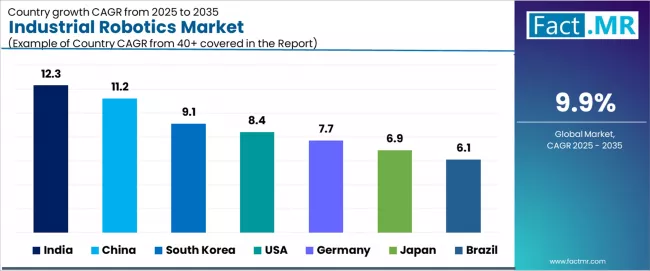
| Region/Country | 2025-2035 Growth | How to win | What to watch out |
|---|---|---|---|
| India | 12.3% | Focus on affordable automation portfolios | Skills availability; infrastructure gaps |
| China | 11.2% | Lead with integrated solution positioning | Domestic competition; slowing growth |
| South Korea | 9.1% | Provide advanced technology solutions | Market saturation; export dependency |
| USA | 8.4% | Offer collaborative robotics technologies | Labor relations; implementation costs |
| Germany | 7.7% | Maintain engineering excellence positioning | Market maturity; price pressures |
| Japan | 6.9% | Push specialized application programs | Aging workforce; domestic saturation |
| Brazil | 6.1% | Deliver cost-effective automation | Economic volatility; investment constraints |
India Drives Fastest Market Growth
India establishes fastest market growth through progressive manufacturing expansion and comprehensive industrial automation infrastructure development, positioning industrial robotics technologies as essential production solutions in manufacturing facilities and emerging industrial complexes.
The country's 12.3% growth rate reflects rising industrial investment levels supporting automation spending and growing manufacturing sectors that encourage the deployment of robotic systems in diverse production settings. Growth concentrates in major manufacturing clusters, including Gujarat, Maharashtra, and Tamil Nadu, where industrial facilities showcase increasing capacity for automated production adoption that appeal to efficiency-focused manufacturers demanding productivity enhancement and quality consistency outcomes.
Indian manufacturing organizations are developing automation strategies that combine international robotic technologies with domestic system integration partnerships, including local integrator expansion and technical training program growth. Distribution channels through industrial automation distributors and robotics system integrators expand market access, while engineering workforce development initiatives support adoption across diverse facility types and manufacturing specialization levels.
China Emerges as Robotics Manufacturing Powerhouse
In Guangdong, Jiangsu, and Zhejiang regions, manufacturing facilities and production plants are adopting advanced industrial robotics technologies as essential automation tools for manufacturing operations, driven by increasing labor cost pressures and elevation of production quality expectations that emphasize the importance of automated manufacturing.
The market holds an 11.2% growth rate, supported by manufacturing park development and automation infrastructure investment that promote robot adoption for production applications. Chinese manufacturers are favoring domestically-produced robots that provide comprehensive automation capabilities and competitive pricing, particularly appealing in manufacturing clusters where cost-effectiveness and local support represent critical operational factors.
Market expansion benefits from substantial manufacturing facility investment and domestic robotics industry establishment that enable widespread adoption of automated production methodologies for diverse manufacturing applications. Industry adoption follows patterns established in manufacturing modernization, where automation advantages and productivity documentation drive manufacturer confidence and production system integration.
South Korea Shows Advanced Manufacturing Leadership
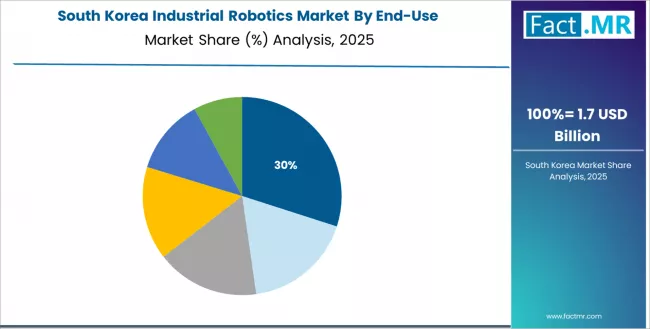
South Korea's sophisticated manufacturing market demonstrates comprehensive industrial robotics integration with documented automation emphasis in production implementation and manufacturing excellence execution through specialized electronics manufacturers and established automotive facilities. The country maintains a 9.1% growth rate, leveraging established robotics industry expertise and comprehensive automation culture in high-tech manufacturing.
Major manufacturing regions, including Seoul metropolitan area and southeastern industrial zones, showcase technology-driven automation priorities where industrial robots integrate with established smart factory environments and systematic production practices to optimize manufacturing efficiency and maintain quality standards under rigorous performance requirements.
Korean manufacturers prioritize advanced automation capabilities and system integration excellence in robotics deployment program implementation, creating demand for high-performance products with extensive technical sophistication, including collaborative features, AI integration, and comprehensive connectivity. The market benefits from established electronics and automotive manufacturing leadership and technology-focused production culture that provide advanced positioning opportunities and maintain alignment with Korean Industry 4.0 initiatives.
USA Shows Collaborative Robotics Leadership
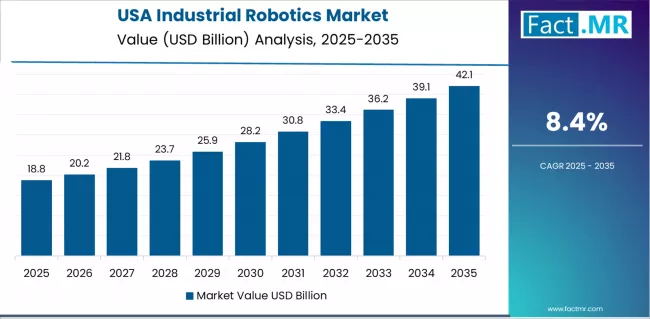
USA establishes collaborative robotics leadership through comprehensive manufacturing infrastructure and established automation ecosystem, integrating industrial robotics technologies across automotive facilities, electronics plants, and general manufacturing operations.
The country's 8.4% growth rate reflects established safety framework maturity and sophisticated manufacturing automation levels that support widespread deployment of robotic systems in production and assembly applications. Growth concentrates in established manufacturing regions, including the Midwest, Southeast, and California, where facilities showcase advanced automation adoption that appeals to productivity-focused operations seeking flexible manufacturing outcomes and comprehensive safety compliance.
American manufacturers leverage established system integrator relationships and comprehensive safety frameworks, including collaborative robot deployment readiness and workforce training programs that create automation confidence and production assurance. The market benefits from substantial manufacturing reshoring initiatives and advanced manufacturing development that encourage premium robot purchases while supporting continuous automation innovation investments and application engineering funding.
Germany Shows Manufacturing Excellence Integration
Germany's advanced industrial market demonstrates sophisticated industrial robotics integration with documented quality emphasis in automation methodology and manufacturing precision through specialized automotive manufacturers and established machinery production networks. The country leverages rigorous engineering principles and evidence-based automation approaches to maintain a 7.7% growth rate.
Premium manufacturing centers, including Bavaria, Baden-Württemberg, and North Rhine-Westphalia, showcase automation excellence priorities where industrial robots integrate with established engineering cultures and thorough production practices to optimize manufacturing confidence and ensure appropriate quality assessment.
German manufacturers prioritize comprehensive system validation and technical documentation in robotics deployment implementation, creating demand for engineering-qualified products with extensive performance characteristics, including precision specifications, reliability data, and comprehensive technical documentation. The market benefits from established automotive and machinery segments and manufacturing engineering maturity that provide differentiation opportunities and compliance with strict German industrial standards.
Japan Demonstrates Robotics Innovation Heritage

Japan's established robotics market demonstrates comprehensive industrial robotics integration with documented automation standards in manufacturing methodology and production excellence execution through leading automotive manufacturers and specialized electronics facilities. The country maintains a 6.9% growth rate, leveraging pioneering robotics heritage and comprehensive manufacturing quality frameworks in industrial automation.
Major manufacturing centers, including Toyota region, Osaka industrial area, and Tokyo manufacturing zones, showcase traditional automation emphasis where industrial robots integrate with established production standards and meticulous manufacturing practices to optimize quality assurance and maintain operational compliance under comprehensive industrial supervision.
Japanese manufacturers prioritize comprehensive automation documentation and production system integration in robotics implementation, creating demand for high-quality products with extensive documentation characteristics, including reliability certification, performance validation, and comprehensive technical reports. The market benefits from established robotics industry reputation and quality-focused manufacturing culture that provide premium positioning opportunities and comply with strict Japanese industrial specifications.
Brazil Shows Manufacturing Automation Potential
Brazil's developing industrial market demonstrates progressive industrial robotics adoption with documented automation interest in manufacturing capacity and production modernization through expanding automotive facilities and established manufacturing operations. The country maintains a 6.1% growth rate, leveraging growing industrial infrastructure and automation awareness in key manufacturing regions.
Major industrial areas, including São Paulo automotive corridor, southern manufacturing zones, and industrial clusters, showcase productivity-focused automation priorities where industrial robots integrate with developing smart manufacturing environments and efficiency improvement approaches to optimize production capabilities and advance manufacturing standards under evolving Brazilian industrial frameworks.
Brazilian manufacturers prioritize cost-effectiveness and productivity improvement in robotics deployment program development, creating demand for value-oriented products with demonstrated ROI, including productivity documentation, total cost of ownership analysis, and affordability positioning. The market benefits from expanding automotive sectors and manufacturing modernization initiatives that provide market development opportunities and support alignment with Brazilian industrial development programs.
Europe Market Split by Country
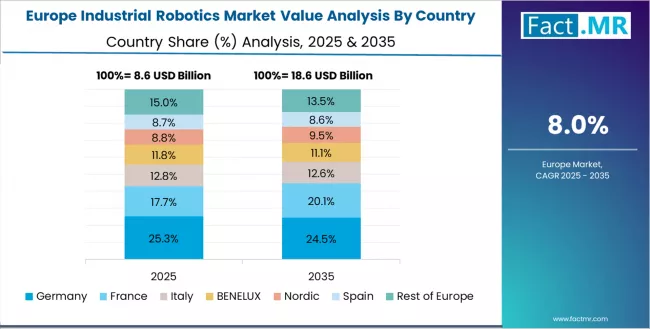
The European industrial robotics market is projected to grow from USD 6.81 billion in 2025 to USD 17.43 billion by 2035, representing 18.0% of the global market in 2025 and maintaining 18.0% by 2035. Germany is expected to maintain its leadership position with USD 1.82 billion in 2025, accounting for 26.8% of the European market, supported by its advanced automotive manufacturing infrastructure and established industrial automation networks.
France follows with USD 1.29 billion, representing 18.9% of the European market in 2025, driven by comprehensive automotive integration and aerospace manufacturing concentration. UK holds USD 1.18 billion with 17.3% market share through established manufacturing facility deployment and industrial automation density.
Italy commands USD 0.97 billion representing 14.2% share, while Spain accounts for USD 0.79 billion or 11.6% in 2025. The rest of Europe maintains USD 0.76 billion, representing 11.2% of the European market, attributed to increasing automation adoption in Nordic countries and emerging Eastern European manufacturing sectors implementing industrial robotics programs.
Competitive Landscape of the Industrial Robotics Market
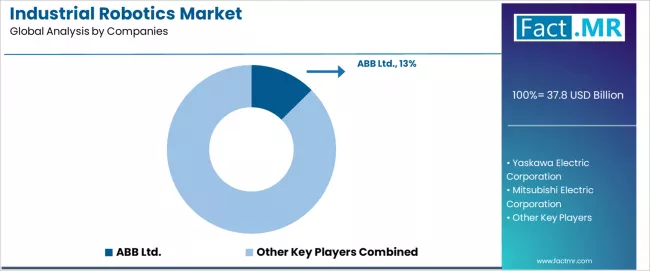
The industrial robotics market exhibits a moderately consolidated competitive structure with approximately 70-90 active players operating across global automation networks and regional system integration distribution portfolios. ABB Ltd. maintains market leadership at a 12.6% share, reflecting strong product portfolio positioning across diverse robotic applications with sophisticated global manufacturing strategies.
This competitive landscape demonstrates the maturation of industrial automation technology, where established players leverage brand recognition advantages, extensive application validation evidence documentation, and manufacturer relationship programs to maintain dominant positions, while emerging collaborative robotics developers and specialized automation companies create niche opportunities through flexible deployment offerings and human-robot collaboration strategies.
Market leadership is maintained through several critical competitive advantages extending beyond manufacturing capabilities and product portfolios. Global distribution networks enable leading players to navigate diverse industrial requirements and access varied manufacturing segments including automotive plants, electronics facilities, and general manufacturing operations.
Technical support infrastructure and application engineering program availability represent crucial differentiators in industrial robotics categories, where decades of automation expertise, process optimization protocols, and system integration frameworks create purchasing preference among productivity-focused manufacturers.
Manufacturing efficiency in precision robot production facilities, supply chain quality management, and component sourcing control separate major suppliers from smaller competitors, while comprehensive technical documentation addressing safety standards, performance validation studies, and reliability data strengthen market position and customer confidence.
The market demonstrates emerging differentiation opportunities in collaborative robotics categories and AI-powered automation technologies, where traditional industrial robots face competition from innovation-focused entrants offering flexible deployment advantages. However, significant competitive advantages persist in established articulated robot categories through comprehensive application proven portfolios and manufacturing relationship depth. Premium positioning strategies with AI integration and advanced sensing capabilities command margin premiums through superior flexibility and adaptive operation integration.
Specialized robot portfolios combining multiple application capabilities with industry-specific configurations create comprehensive positioning that justifies higher price points beyond commodity robot competition. Integrated automation solution offerings emphasizing complementary equipment compatibility, unified programming platforms, and cross-application training programs generate brand loyalty and system preferences beyond transactional robot purchases.
| Stakeholder | What they actually control | Typical strengths | Typical blind spots |
|---|---|---|---|
| Global robotics corporations | Comprehensive robot portfolios; global manufacturing; technical documentation | Brand recognition; application validation; OEM relationships; service networks | Innovation speed; customization flexibility; pricing adaptability; niche applications |
| Specialized robotics manufacturers | Technology innovation; robot design; application optimization | Product differentiation; technical sophistication; engineering support; customer loyalty | Market penetration; production scale; cost competitiveness; geographic coverage |
| Collaborative robot developers | Cobot technology; safety systems; ease-of-use design | Flexibility positioning; deployment simplicity; workspace sharing; SME accessibility | Payload limitations; speed constraints; heavy industry applications; established competition |
| System integrators | Application engineering; custom solutions; installation services; local support | Customer intimacy; application expertise; service delivery; regional presence | Robot manufacturing; technology development; global scale; brand recognition |
| Automotive OEMs | Application requirements; volume demand; specification development; end-user influence | Market leverage; technical requirements; volume scale; process expertise | Robot manufacturing; technology innovation; supplier diversification; cost optimization |
Key Players in the Industrial Robotics Market
- ABB Ltd.
- Yaskawa Electric Corporation
- Mitsubishi Electric Corporation
- Nachi-Fujikoshi Corp.
- Comau SpA
- KUKA AG
- Fanuc Corporation
- Denso Corporation
- Kawasaki Heavy Industries Ltd.
- Omron Corporation
- Universal Robots
- Epson Robotics
- Staubli Robotics
- Adept Technologies
- Hyundai Robotics
Scope of the Report
| Items | Values |
|---|---|
| Quantitative Units (2025) | USD 37.82 billion |
| Application | Handling, Welding & Soldering, Assembling & Disassembling, Processing, Dispensing, Cleanroom, Others |
| End-Use | Electricals/electronics, Automotive, Metal/Heavy Machinery, Chemical, Rubber & Plastics, Food, Others |
| Regions Covered | North America, Europe, Asia Pacific, Latin America, Middle East & Africa |
| Countries Covered | USA, China, India, Germany, Japan, South Korea, Brazil, and 15+ additional countries |
| Key Companies Profiled | ABB Ltd., Yaskawa Electric Corporation, Mitsubishi Electric Corporation, Nachi-Fujikoshi Corp., Comau SpA, KUKA AG, Fanuc Corporation, Denso Corporation |
| Additional Attributes | Dollar sales by application and end-use categories, regional adoption trends across Asia Pacific, Europe, and North America, competitive landscape with established robotics corporations and specialized automation companies, manufacturer preferences for handling applications and production efficiency, integration with automotive manufacturing facilities and electronics assembly operations, innovations in collaborative robotics technologies and AI-powered automation platforms, and development of sophisticated robotic systems with enhanced flexibility profiles and comprehensive safety documentation frameworks. |
Industrial Robotics Market by Segments
-
Application :
- Handling
- Welding & Soldering
- Assembling & Disassembling
- Processing
- Dispensing
- Cleanroom
- Others
-
End-Use :
- Electricals/electronics
- Automotive
- Metal/Heavy Machinery
- Chemical, Rubber & Plastics
- Food
- Others
-
Region :
- North America
- USA
- Canada
- Mexico
- Europe
- Germany
- France
- UK
- Italy
- Spain
- Rest of Europe
- Asia Pacific
- India
- China
- Japan
- South Korea
- ASEAN
- Australia & New Zealand
- Rest of Asia Pacific
- Latin America
- Brazil
- Rest of Latin America
- Middle East & Africa
- GCC Countries
- South Africa
- Rest of Middle East & Africa
- North America
Table of Content
- Executive Summary
- Global Market Outlook
- Demand to side Trends
- Supply to side Trends
- Technology Roadmap Analysis
- Analysis and Recommendations
- Market Overview
- Market Coverage / Taxonomy
- Market Definition / Scope / Limitations
- Market Background
- Market Dynamics
- Drivers
- Restraints
- Opportunity
- Trends
- Scenario Forecast
- Demand in Optimistic Scenario
- Demand in Likely Scenario
- Demand in Conservative Scenario
- Opportunity Map Analysis
- Product Life Cycle Analysis
- Supply Chain Analysis
- Investment Feasibility Matrix
- Value Chain Analysis
- PESTLE and Porter’s Analysis
- Regulatory Landscape
- Regional Parent Market Outlook
- Production and Consumption Statistics
- Import and Export Statistics
- Market Dynamics
- Global Market Analysis 2020 to 2024 and Forecast, 2025 to 2035
- Historical Market Size Value (USD Million) Analysis, 2020 to 2024
- Current and Future Market Size Value (USD Million) Projections, 2025 to 2035
- Y to o to Y Growth Trend Analysis
- Absolute $ Opportunity Analysis
- Global Market Pricing Analysis 2020 to 2024 and Forecast 2025 to 2035
- Global Market Analysis 2020 to 2024 and Forecast 2025 to 2035, By Application
- Introduction / Key Findings
- Historical Market Size Value (USD Million) Analysis By Application, 2020 to 2024
- Current and Future Market Size Value (USD Million) Analysis and Forecast By Application, 2025 to 2035
- Handling
- Welding & Soldering
- Assembling & Disassembling
- Processing
- Dispensing
- Cleanroom
- Others
- Y to o to Y Growth Trend Analysis By Application, 2020 to 2024
- Absolute $ Opportunity Analysis By Application, 2025 to 2035
- Global Market Analysis 2020 to 2024 and Forecast 2025 to 2035, By End-Use
- Introduction / Key Findings
- Historical Market Size Value (USD Million) Analysis By End-Use, 2020 to 2024
- Current and Future Market Size Value (USD Million) Analysis and Forecast By End-Use, 2025 to 2035
- Electricals/Electronics
- Automotive
- Metal/Heavy Machinery
- Chemical, Rubber & Plastics
- Food
- Others
- Y to o to Y Growth Trend Analysis By End-Use, 2020 to 2024
- Absolute $ Opportunity Analysis By End-Use, 2025 to 2035
- Global Market Analysis 2020 to 2024 and Forecast 2025 to 2035, By Region
- Introduction
- Historical Market Size Value (USD Million) Analysis By Region, 2020 to 2024
- Current Market Size Value (USD Million) Analysis and Forecast By Region, 2025 to 2035
- North America
- Latin America
- Western Europe
- Eastern Europe
- East Asia
- South Asia and Pacific
- Middle East & Africa
- Market Attractiveness Analysis By Region
- North America Market Analysis 2020 to 2024 and Forecast 2025 to 2035, By Country
- Historical Market Size Value (USD Million) Trend Analysis By Market Taxonomy, 2020 to 2024
- Market Size Value (USD Million) Forecast By Market Taxonomy, 2025 to 2035
- By Country
- USA
- Canada
- Mexico
- By Application
- By End-Use
- By Country
- Market Attractiveness Analysis
- By Country
- By Application
- By End-Use
- Key Takeaways
- Latin America Market Analysis 2020 to 2024 and Forecast 2025 to 2035, By Country
- Historical Market Size Value (USD Million) Trend Analysis By Market Taxonomy, 2020 to 2024
- Market Size Value (USD Million) Forecast By Market Taxonomy, 2025 to 2035
- By Country
- Brazil
- Chile
- Rest of Latin America
- By Application
- By End-Use
- By Country
- Market Attractiveness Analysis
- By Country
- By Application
- By End-Use
- Key Takeaways
- Western Europe Market Analysis 2020 to 2024 and Forecast 2025 to 2035, By Country
- Historical Market Size Value (USD Million) Trend Analysis By Market Taxonomy, 2020 to 2024
- Market Size Value (USD Million) Forecast By Market Taxonomy, 2025 to 2035
- By Country
- Germany
- UK
- Italy
- Spain
- France
- Nordic
- BENELUX
- Rest of Western Europe
- By Application
- By End-Use
- By Country
- Market Attractiveness Analysis
- By Country
- By Application
- By End-Use
- Key Takeaways
- Eastern Europe Market Analysis 2020 to 2024 and Forecast 2025 to 2035, By Country
- Historical Market Size Value (USD Million) Trend Analysis By Market Taxonomy, 2020 to 2024
- Market Size Value (USD Million) Forecast By Market Taxonomy, 2025 to 2035
- By Country
- Russia
- Poland
- Hungary
- Balkan & Baltic
- Rest of Eastern Europe
- By Application
- By End-Use
- By Country
- Market Attractiveness Analysis
- By Country
- By Application
- By End-Use
- Key Takeaways
- East Asia Market Analysis 2020 to 2024 and Forecast 2025 to 2035, By Country
- Historical Market Size Value (USD Million) Trend Analysis By Market Taxonomy, 2020 to 2024
- Market Size Value (USD Million) Forecast By Market Taxonomy, 2025 to 2035
- By Country
- China
- Japan
- South Korea
- By Application
- By End-Use
- By Country
- Market Attractiveness Analysis
- By Country
- By Application
- By End-Use
- Key Takeaways
- South Asia and Pacific Market Analysis 2020 to 2024 and Forecast 2025 to 2035, By Country
- Historical Market Size Value (USD Million) Trend Analysis By Market Taxonomy, 2020 to 2024
- Market Size Value (USD Million) Forecast By Market Taxonomy, 2025 to 2035
- By Country
- India
- ASEAN
- Australia & New Zealand
- Rest of South Asia and Pacific
- By Application
- By End-Use
- By Country
- Market Attractiveness Analysis
- By Country
- By Application
- By End-Use
- Key Takeaways
- Middle East & Africa Market Analysis 2020 to 2024 and Forecast 2025 to 2035, By Country
- Historical Market Size Value (USD Million) Trend Analysis By Market Taxonomy, 2020 to 2024
- Market Size Value (USD Million) Forecast By Market Taxonomy, 2025 to 2035
- By Country
- Kingdom of Saudi Arabia
- Other GCC Countries
- Turkiye
- South Africa
- Other African Union
- Rest of Middle East & Africa
- By Application
- By End-Use
- By Country
- Market Attractiveness Analysis
- By Country
- By Application
- By End-Use
- Key Takeaways
- Key Countries Market Analysis
- USA
- Pricing Analysis
- Market Share Analysis, 2024
- By Application
- By End-Use
- Canada
- Pricing Analysis
- Market Share Analysis, 2024
- By Application
- By End-Use
- Mexico
- Pricing Analysis
- Market Share Analysis, 2024
- By Application
- By End-Use
- Brazil
- Pricing Analysis
- Market Share Analysis, 2024
- By Application
- By End-Use
- Chile
- Pricing Analysis
- Market Share Analysis, 2024
- By Application
- By End-Use
- Germany
- Pricing Analysis
- Market Share Analysis, 2024
- By Application
- By End-Use
- UK
- Pricing Analysis
- Market Share Analysis, 2024
- By Application
- By End-Use
- Italy
- Pricing Analysis
- Market Share Analysis, 2024
- By Application
- By End-Use
- Spain
- Pricing Analysis
- Market Share Analysis, 2024
- By Application
- By End-Use
- France
- Pricing Analysis
- Market Share Analysis, 2024
- By Application
- By End-Use
- India
- Pricing Analysis
- Market Share Analysis, 2024
- By Application
- By End-Use
- ASEAN
- Pricing Analysis
- Market Share Analysis, 2024
- By Application
- By End-Use
- Australia & New Zealand
- Pricing Analysis
- Market Share Analysis, 2024
- By Application
- By End-Use
- China
- Pricing Analysis
- Market Share Analysis, 2024
- By Application
- By End-Use
- Japan
- Pricing Analysis
- Market Share Analysis, 2024
- By Application
- By End-Use
- South Korea
- Pricing Analysis
- Market Share Analysis, 2024
- By Application
- By End-Use
- Russia
- Pricing Analysis
- Market Share Analysis, 2024
- By Application
- By End-Use
- Poland
- Pricing Analysis
- Market Share Analysis, 2024
- By Application
- By End-Use
- Hungary
- Pricing Analysis
- Market Share Analysis, 2024
- By Application
- By End-Use
- Kingdom of Saudi Arabia
- Pricing Analysis
- Market Share Analysis, 2024
- By Application
- By End-Use
- Turkiye
- Pricing Analysis
- Market Share Analysis, 2024
- By Application
- By End-Use
- South Africa
- Pricing Analysis
- Market Share Analysis, 2024
- By Application
- By End-Use
- USA
- Market Structure Analysis
- Competition Dashboard
- Competition Benchmarking
- Market Share Analysis of Top Players
- By Regional
- By Application
- By End-Use
- Competition Analysis
- Competition Deep Dive
- ABB Ltd.
- Overview
- Product Portfolio
- Profitability by Market Segments (Product/Age /Sales Channel/Region)
- Sales Footprint
- Strategy Overview
- Marketing Strategy
- Product Strategy
- Channel Strategy
- Yaskawa Electric Corporation
- Mitsubishi Electric Corporation
- Nachi-Fujikoshi Corp.
- Comau SpA
- KUKA AG
- Fanuc Corporation
- Denso Corporation
- Kawasaki Heavy Industries Ltd.
- Omron Corporation
- Universal Robots
- Epson Robotics
- Staubli Robotics
- Adept Technologies
- Hyundai Robotics
- ABB Ltd.
- Competition Deep Dive
- Assumptions & Acronyms Used
- Research Methodology
List Of Table
- Table 1: Global Market Value (USD Million) Forecast by Region, 2020 to 2035
- Table 2: Global Market Value (USD Million) Forecast by Application, 2020 to 2035
- Table 3: Global Market Value (USD Million) Forecast by End-Use, 2020 to 2035
- Table 4: North America Market Value (USD Million) Forecast by Country, 2020 to 2035
- Table 5: North America Market Value (USD Million) Forecast by Application, 2020 to 2035
- Table 6: North America Market Value (USD Million) Forecast by End-Use, 2020 to 2035
- Table 7: Latin America Market Value (USD Million) Forecast by Country, 2020 to 2035
- Table 8: Latin America Market Value (USD Million) Forecast by Application, 2020 to 2035
- Table 9: Latin America Market Value (USD Million) Forecast by End-Use, 2020 to 2035
- Table 10: Western Europe Market Value (USD Million) Forecast by Country, 2020 to 2035
- Table 11: Western Europe Market Value (USD Million) Forecast by Application, 2020 to 2035
- Table 12: Western Europe Market Value (USD Million) Forecast by End-Use, 2020 to 2035
- Table 13: Eastern Europe Market Value (USD Million) Forecast by Country, 2020 to 2035
- Table 14: Eastern Europe Market Value (USD Million) Forecast by Application, 2020 to 2035
- Table 15: Eastern Europe Market Value (USD Million) Forecast by End-Use, 2020 to 2035
- Table 16: East Asia Market Value (USD Million) Forecast by Country, 2020 to 2035
- Table 17: East Asia Market Value (USD Million) Forecast by Application, 2020 to 2035
- Table 18: East Asia Market Value (USD Million) Forecast by End-Use, 2020 to 2035
- Table 19: South Asia and Pacific Market Value (USD Million) Forecast by Country, 2020 to 2035
- Table 20: South Asia and Pacific Market Value (USD Million) Forecast by Application, 2020 to 2035
- Table 21: South Asia and Pacific Market Value (USD Million) Forecast by End-Use, 2020 to 2035
- Table 22: Middle East & Africa Market Value (USD Million) Forecast by Country, 2020 to 2035
- Table 23: Middle East & Africa Market Value (USD Million) Forecast by Application, 2020 to 2035
- Table 24: Middle East & Africa Market Value (USD Million) Forecast by End-Use, 2020 to 2035
List Of Figures
- Figure 1: Global Market Pricing Analysis
- Figure 2: Global Market Value (USD Million) Forecast 2020 to 2035
- Figure 3: Global Market Value Share and BPS Analysis by Application, 2025 and 2035
- Figure 4: Global Market Y to o to Y Growth Comparison by Application, 2025 to 2035
- Figure 5: Global Market Attractiveness Analysis by Application
- Figure 6: Global Market Value Share and BPS Analysis by End-Use, 2025 and 2035
- Figure 7: Global Market Y to o to Y Growth Comparison by End-Use, 2025 to 2035
- Figure 8: Global Market Attractiveness Analysis by End-Use
- Figure 9: Global Market Value (USD Million) Share and BPS Analysis by Region, 2025 and 2035
- Figure 10: Global Market Y to o to Y Growth Comparison by Region, 2025 to 2035
- Figure 11: Global Market Attractiveness Analysis by Region
- Figure 12: North America Market Incremental Dollar Opportunity, 2025 to 2035
- Figure 13: Latin America Market Incremental Dollar Opportunity, 2025 to 2035
- Figure 14: Western Europe Market Incremental Dollar Opportunity, 2025 to 2035
- Figure 15: Eastern Europe Market Incremental Dollar Opportunity, 2025 to 2035
- Figure 16: East Asia Market Incremental Dollar Opportunity, 2025 to 2035
- Figure 17: South Asia and Pacific Market Incremental Dollar Opportunity, 2025 to 2035
- Figure 18: Middle East & Africa Market Incremental Dollar Opportunity, 2025 to 2035
- Figure 19: North America Market Value Share and BPS Analysis by Country, 2025 and 2035
- Figure 20: North America Market Value Share and BPS Analysis by Application, 2025 and 2035
- Figure 21: North America Market Y to o to Y Growth Comparison by Application, 2025 to 2035
- Figure 22: North America Market Attractiveness Analysis by Application
- Figure 23: North America Market Value Share and BPS Analysis by End-Use, 2025 and 2035
- Figure 24: North America Market Y to o to Y Growth Comparison by End-Use, 2025 to 2035
- Figure 25: North America Market Attractiveness Analysis by End-Use
- Figure 26: Latin America Market Value Share and BPS Analysis by Country, 2025 and 2035
- Figure 27: Latin America Market Value Share and BPS Analysis by Application, 2025 and 2035
- Figure 28: Latin America Market Y to o to Y Growth Comparison by Application, 2025 to 2035
- Figure 29: Latin America Market Attractiveness Analysis by Application
- Figure 30: Latin America Market Value Share and BPS Analysis by End-Use, 2025 and 2035
- Figure 31: Latin America Market Y to o to Y Growth Comparison by End-Use, 2025 to 2035
- Figure 32: Latin America Market Attractiveness Analysis by End-Use
- Figure 33: Western Europe Market Value Share and BPS Analysis by Country, 2025 and 2035
- Figure 34: Western Europe Market Value Share and BPS Analysis by Application, 2025 and 2035
- Figure 35: Western Europe Market Y to o to Y Growth Comparison by Application, 2025 to 2035
- Figure 36: Western Europe Market Attractiveness Analysis by Application
- Figure 37: Western Europe Market Value Share and BPS Analysis by End-Use, 2025 and 2035
- Figure 38: Western Europe Market Y to o to Y Growth Comparison by End-Use, 2025 to 2035
- Figure 39: Western Europe Market Attractiveness Analysis by End-Use
- Figure 40: Eastern Europe Market Value Share and BPS Analysis by Country, 2025 and 2035
- Figure 41: Eastern Europe Market Value Share and BPS Analysis by Application, 2025 and 2035
- Figure 42: Eastern Europe Market Y to o to Y Growth Comparison by Application, 2025 to 2035
- Figure 43: Eastern Europe Market Attractiveness Analysis by Application
- Figure 44: Eastern Europe Market Value Share and BPS Analysis by End-Use, 2025 and 2035
- Figure 45: Eastern Europe Market Y to o to Y Growth Comparison by End-Use, 2025 to 2035
- Figure 46: Eastern Europe Market Attractiveness Analysis by End-Use
- Figure 47: East Asia Market Value Share and BPS Analysis by Country, 2025 and 2035
- Figure 48: East Asia Market Value Share and BPS Analysis by Application, 2025 and 2035
- Figure 49: East Asia Market Y to o to Y Growth Comparison by Application, 2025 to 2035
- Figure 50: East Asia Market Attractiveness Analysis by Application
- Figure 51: East Asia Market Value Share and BPS Analysis by End-Use, 2025 and 2035
- Figure 52: East Asia Market Y to o to Y Growth Comparison by End-Use, 2025 to 2035
- Figure 53: East Asia Market Attractiveness Analysis by End-Use
- Figure 54: South Asia and Pacific Market Value Share and BPS Analysis by Country, 2025 and 2035
- Figure 55: South Asia and Pacific Market Value Share and BPS Analysis by Application, 2025 and 2035
- Figure 56: South Asia and Pacific Market Y to o to Y Growth Comparison by Application, 2025 to 2035
- Figure 57: South Asia and Pacific Market Attractiveness Analysis by Application
- Figure 58: South Asia and Pacific Market Value Share and BPS Analysis by End-Use, 2025 and 2035
- Figure 59: South Asia and Pacific Market Y to o to Y Growth Comparison by End-Use, 2025 to 2035
- Figure 60: South Asia and Pacific Market Attractiveness Analysis by End-Use
- Figure 61: Middle East & Africa Market Value Share and BPS Analysis by Country, 2025 and 2035
- Figure 62: Middle East & Africa Market Value Share and BPS Analysis by Application, 2025 and 2035
- Figure 63: Middle East & Africa Market Y to o to Y Growth Comparison by Application, 2025 to 2035
- Figure 64: Middle East & Africa Market Attractiveness Analysis by Application
- Figure 65: Middle East & Africa Market Value Share and BPS Analysis by End-Use, 2025 and 2035
- Figure 66: Middle East & Africa Market Y to o to Y Growth Comparison by End-Use, 2025 to 2035
- Figure 67: Middle East & Africa Market Attractiveness Analysis by End-Use
- Figure 68: Global Market - Tier Structure Analysis
- Figure 69: Global Market - Company Share Analysis
- FAQs -
How big is the industrial robotics market in 2025?
The global industrial robotics market is estimated to be valued at USD 37.8 billion in 2025.
What will be the size of industrial robotics market in 2035?
The market size for the industrial robotics market is projected to reach USD 96.8 billion by 2035.
How much will be the industrial robotics market growth between 2025 and 2035?
The industrial robotics market is expected to grow at a 9.9% CAGR between 2025 and 2035.
What are the key product types in the industrial robotics market?
The key product types in industrial robotics market are handling, welding & soldering, assembling & disassembling, processing, dispensing, cleanroom and others.
Which end-use segment to contribute significant share in the industrial robotics market in 2025?
In terms of end-use, electricals/electronics segment to command 31.0% share in the industrial robotics market in 2025.